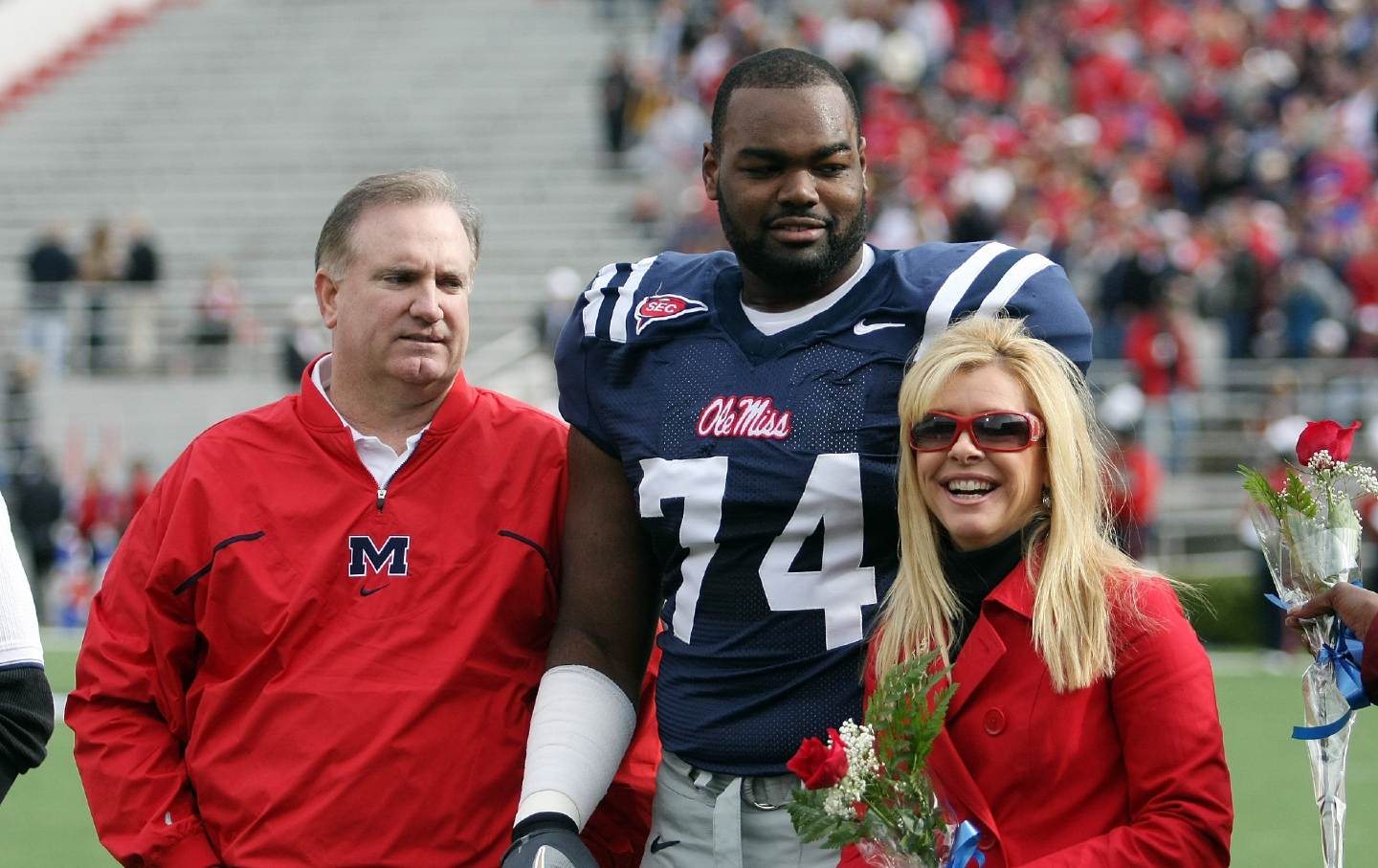The Blind Side Was Always Trash
“The Blind Side” Was Always Trash
The book and movie about former NFL lineman Michael Oher lean into the white-savior trope. They were terrible long before the allegations that they were based on lies.

Michael Oher stands with Sean and Leigh Anne Tuohy, people who claimed to be his adoptive parents, prior to an Ole Miss game on November 28, 2008 in Oxford, Miss.
Popular
"swipe left below to view more authors"Swipe →
If retired NFL offensive lineman Michael Oher had his life rights stolen by Sean and Leigh Anne Tuohy—people who claimed to be his adopted parents—then the Tuohys have enacted a rancid and larcenous grift.
A 14-page complaint filed in Shelby County, Tenn., says—contrary to the narrative that became a best-selling book and hit movie—that the Tuohys never adopted Oher. Instead, three months after he turned 18, the Tuohys tricked him into signing a document that made them his conservators, leaving him with fewer legal rights than a child.
If the charges are true, then the book and movie, which grossed $300 million and helped win Sandra Bullock a Best Actress Oscar, was part of a racket that leveraged white America’s love affair with itself to scam Oher out of millions.
The author of the book about Oher and the Tuohys, sales machine Michael “Moneyball” Lewis, should also be compelled to answer some uncomfortable questions as to how he was duped. It was Lewis who spun this piece of Caucasian catnip: the tale of the white, southern, Christian Tuohy family who adopted troubled teen Michael Oher—presented in the book and film as an impoverished simple-minded behemoth—and turned him into a wealthy pro football player.
Now, Oher is saying in court documents that he discovered several months ago, while going through legal papers, that he had never actually been adopted by the Tuohys. It was a sham perpetrated without his consent in order to get him to sign over his life’s rights for nothing. They were not parents in any legal or moral sense. They were conservators: Think Britney Spears’s dad. As ESPN’s Michael Fletcher wrote in his exposé: “The Tuohys used their power as conservators to strike a deal that paid them and their two birth children millions of dollars in royalties…while Oher got nothing for a story ‘that would not have existed without him.’”
For the film, the Tuohys’ two children each got a $225,000 payment and 2.5 percent of net proceeds for having their likeness portrayed. That would work out to almost $5 million per kid. Oher allegedly got nothing. With that film deal, Sean and Leigh Anne tipped their hands as to whom they really considered family. Yet this alleged swindle is only an extension of what is so grotesque about The Blind Side. It’s a “feel-good story” that, even without this lawsuit, is hyper-exploitative trash. The smash hit stars Sandra Bullock as the white woman with a heart of gold. Hollywood rarely fails with this trope, which tells white America that it is—despite historic evidence to the contrary—morally righteous to accept Rudyard Kipling’s “white man’s burden” and civilize the poor and downtrodden. This has been used by “liberal” Hollywood since at least 1939, when Scarlett O’Hara let Mammy sass her out of the goodness of her heart in Gone With the Wind. The list of white-savior prestige films is long—Mississippi Burning, Dangerous Minds, and the fulsomely praised documentary about school reform Waiting for Superman come to mind. All of these movies sell the same tired fiction.
When The Blind Side film was released in 2009, the allegedly “slow” Oher spoke out against his “Baby Huey” depiction and refused to do publicity. Few noticed or wrote about it at the time. Oher may not have known about the fake adoption then, but he knew the one thing about the movie that the Academy did not: It was a terrible and racist film.
The emerging truth about The Blind Side fits neatly within our cultural moment. We are living in an era where people are realizing that waiting for a Superman is a fool’s pursuit and that people who present themselves as white saviors are more often than not white beneficiaries of Black pain. If the charges are true—and the court documents are damning—then maybe this will be a turning point. Maybe even white audiences will stop believing in this trope.
There already is a growing understanding among young white activists about the difference between allyship and paternalism, the importance of creating space for others to speak and lead, and the understanding that the white-savior concept is a dangerous myth that has hurt far more than it has ever helped. Lewis was wrong to valorize this narrative. The Tuohys were wrong to exploit it, which they did whether these charges are proven or not. And Oher is right to take his name back. He’s a hell of a lot smarter than Lewis or the Tuohys have presented, and that may prove to be their undoing. The flip side of white saviorship is white underestimation. The Tuohys underestimated Michael Oher. And now the world knows it.


